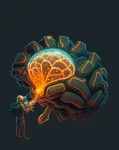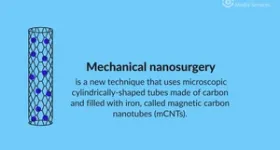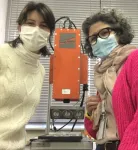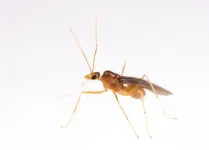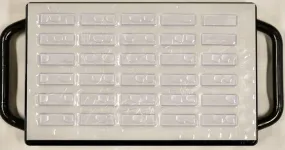(Press-News.org) Scientists at The Hospital for Sick Children (SickKids) and the University of Toronto (U of T) have combined forces to develop a new approach to potentially treat tumour cells, called mechanical nanosurgery, even for aggressive, chemoresistant cancers.
Glioblastoma (GBM) is the most common and aggressive primary brain cancer. Despite various treatment options that exist, including surgery, radiotherapy, and chemotherapy, the median survival time for patients is only around 15 months.
The current global standard-of-care treatment for GBM patients includes chemotherapy using a drug called temozolomide (TMZ), which extends a person’s life expectancy by approximately two months compared to patients receiving radiotherapy alone. However, GBM cells can develop resistance to TMZ over time, reducing its efficacy and increasing the likelihood of tumour relapse.
In a study published in Science Advances, Dr. Xi Huang, a Senior Scientist in the Developmental & Stem Cell Biology program at SickKids, and Dr. Yu Sun, Professor of Mechanical Engineering and Director of the Robotics Institute at U of T, present a new approach to treat chemoresistant GBM using precision magnetic control in a process they call mechanical nanosurgery.
“Through the use of nanotechnology deep inside cancer cells, mechanical nanosurgery is a ‘Trojan Horse’ approach that could allow us to destroy tumour cells from within,” says Huang, whose previous research demonstrating that brain tumour cells are mechanosensitive helped to inform the approach. “By combining our expertise in biochemistry at SickKids and engineering at U of T, we’ve developed a potential new way to treat aggressive brain cancer.”
Developed with first author Dr. Xian Wang, current Assistant Professor at Queen’s University, former post-doctoral fellow in the Huang Lab and winner of a Lap-Chee Tsui Fellowship through the SickKids Research Training Centre, the mouse model used in the study showed that the mechanical nanosurgery process reduced GBM tumour size universally, including in TMZ-resistant GBM.
How mechanical nanosurgery works
Magnetic carbon nanotubes (mCNTs) are a form of nanomaterial – microscopic cylindrically-shaped tubes made of carbon and, in this case, filled with iron that becomes magnetized when activated by an external magnetic field. In the study, the research team coated mCNTs with an antibody that recognizes a specific protein associated with GBM tumour cells. Once injected into the tumour, the antibodies on the mCNTs cause them to seek out tumour cells and are absorbed by them.
“Once the nanotubes are inside the tumour cell, we use a rotating magnetic field to mechanically mobilize the nanotubes to provide mechanical stimulation,” says Sun. “The force exerted by the nanotubes damages cellular structures and cause tumour cell death.”
Exploring applications beyond brain cancer
Huang’s partnership with Sun at the U of T Department of Mechanical Engineering is continuing to build on the study findings. As their research continues, they note that mechanical nanosurgery may have further applications in other cancer types.
“Theoretically, by changing the antibody coating and redirecting nanotubes to the desired tumour site, we could potentially have a means to precisely destroy tumour cells in other cancers,” says Huang.
This research was funded by the Canadian Institutes of Health Research (CIHR), National Sciences and Engineering Research Council, Ontario Research Fund, Canadian Cancer Society, Concern Foundation, b.r.a.i.n.child, Sontag Foundation, Meagan’s HUG, Ontario Institute for Cancer Research, Brain Tumour Foundation of Canada, Hopper-Belmont Foundation, Arthur and Sonia Labatt Brain Tumour Research Centre, Garron Family Cancer Centre, and SickKids Foundation.
END
Precision magnetics could be game-changer for therapy-resistant brain cancers
2023-04-11
ELSE PRESS RELEASES FROM THIS DATE:
Migratory birds can partially offset climate change
2023-04-11
Ithaca, NY—Deteriorating habitat conditions caused by climate change are wreaking havoc with the timing of bird migration. A new study demonstrates that birds can partially compensate for these changes by delaying the start of spring migration and completing the journey faster. But the strategy comes with a cost—a decline in overall survival. The findings by researchers from Cornell University, the University of Maryland, and Georgetown University are published in the journal Ecology.
"We found that our study species, the American Redstart, can migrate up to 43% faster to reach its ...
KICT represents Korea in IEA’s Energy in Buildings and Communities Programme
2023-04-11
The Korea Institute of Civil Engineering and Building Technology (KICT, President Kim, Byung-suk) has been participating as Korea’s representative organization in the Energy in Buildings and Communities (EBC) programme, an Technical Cooperation Programme under the International Energy Agency (IEA), since 2005.
The International Energy Agency Energy in Buildings and Communities Programme (IEA EBC) is an international research organization with 25 member countries including the United States, Japan, Germany, France, and, more recently, Brazil and Turkey. Established in 1977 in response to the global energy crisis, EBC aims to conduct research on conserving energy and ...
Your baby’s gut is crawling with unknown viruses
2023-04-11
Viruses are usually associated with illness. But our bodies are full of both bacteria and viruses that constantly proliferate and interact with each other in our gastrointestinal tract. While we have known for decades that gut bacteria in young children are vital to protect them from chronic diseases later on in life, our knowledge about the many viruses found there is minimal.
A few years back, this gave University of Copenhagen professor Dennis Sandris Nielsen the idea to delve more deeply into this ...
Gossip influences who gets ahead in different cultures
2023-04-11
VANCOUVER, Wash. – Gossip influences if people receive advantages whether they work in an office in the U.S. or in India—or even in a remote village in Africa, a Washington State University study found.
In a set of experiments, WSU anthropologists found that positive and negative gossip influenced whether participants were willing to give a person a resource, such as a raise or a family heirloom, especially when the gossip was specific to the circumstance. For instance, positive gossip concerning ...
Wireless pacemakers may be safe, effective for children with irregular heart rhythms
2023-04-11
Research Highlights:
A wireless or leadless (without wires) pacemaker was implanted in a select group of children with irregular heart rhythms during a 5-year period (2016-2021).
Smaller catheters that allow easier placement of the leadless pacemaker in children’s smaller bodies may expand wireless pacemakers as an option to consider for more children with irregular heart rhythms.
DALLAS, April 11, 2023 — Wireless or leadless pacemakers, commonly implanted in adults, may be a safe and effective short-term ...
Protecting the cultural heritage of ancient bone artifacts is now possible. Near-infrared hyperspectral imaging and radiocarbon dating together to make the invisible visible
2023-04-11
An innovative method developed by an Italian team is emerging that will revolutionize the field of archaeology and radiocarbon dating and protect our cultural heritage. The researchers have used it with surprising results on archaeological bones, making the ‘invisible’ visible.
This important achievement-published in the journal Communications Chemistry of the Nature group-is the result of extensive research work coordinated by Professor Sahra Talamo, in which experts in the field of analytical chemistry from the University of Bologna and the University of Genoa collaborated.
The group has developed a new technique for analyzing archaeological ...
Worldwide, those with ‘traditional’ values adhered more strictly to COVID precautions
2023-04-11
Given the battles over COVID-19 rules and recommendations in the United States over the past three years, the findings of a new UCLA-led study may come as a bit of a shock: Globally, those who professed to hold traditional values tended to adhere more closely to coronavirus-prevention measures than those who considered themselves more liberal.
“Across a wide range of countries, people who endorsed traditional cultural values — a position that often underlies socially conservative political philosophies — ...
Male yellow crazy ants are real-life chimeras
2023-04-11
The yellow crazy ant, or Anoplolepis gracilipes, has the infamous distinction of being among the worst invasive species in the world. However, this is not the reason for which this particular ant is studied by a team of international researchers. What interests them is how the insects reproduce, because males of this ant have long perplexed scientists. "The results of previous genetic analyses of the yellow crazy ant have shown that the males of this species have two copies of each chromosome. This was highly unexpected, as males usually develop from unfertilized eggs in ants, bees, and wasps – and thus should only have one maternal copy of each chromosome," explained Dr. ...
Study shows patterns of opioid prescribing linked to suicide risk
2023-04-11
Controversy surrounds the effects of policies to reduce opioid prescriptions on suicide rates. There are concerns that rapid reductions in prescription opioids might provoke increased suicide risk among people who become desparate after they are taken off opioids. According to a new study at Columbia University Mailman School of Public Health and Columbia University Irving Medical Center, however, changes in regional opioid prescribing and regional suicide rates tend to move in the same direction. This relationship held for rates of opioid prescribing, rates of high-dose prescribing and long-term prescribing, and having multiple opioid prescribers. Until ...
Assessing the accuracy of artery models
2023-04-11
Testing the material used to build models of arteries reveals their suitability for use in medical education and surgical planning.
Hokkaido University researchers have analyzed the suitability of a smooth, flexible and transparent material used to make model arteries for use in medical teaching and to plan for surgery on individual patients. Their work is described in the Journal of Vascular and Interventional Radiology.
Ever-improving 3D printing technology can create models of blood vessels that are significantly more realistic than those made with more conventional methods, and also much more suitable for surgical ...
